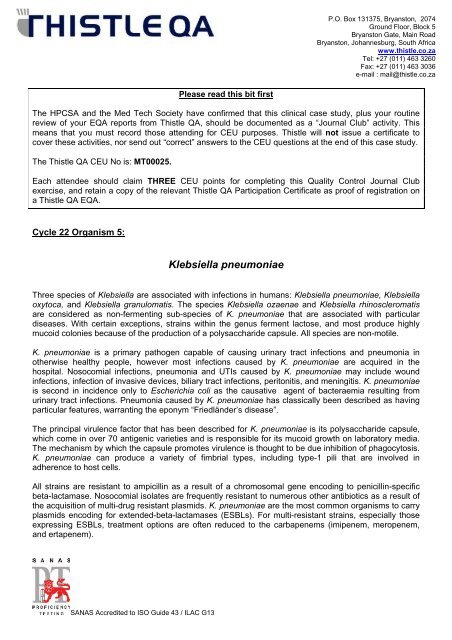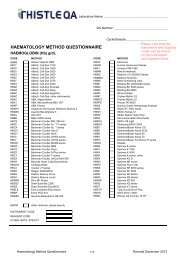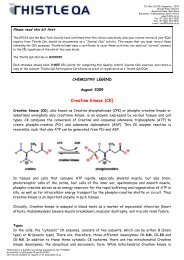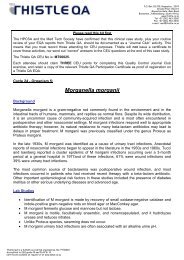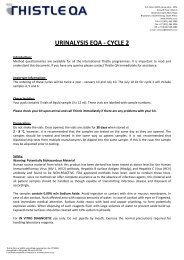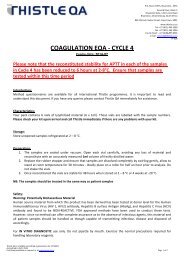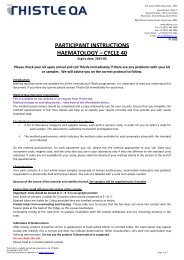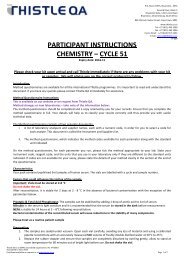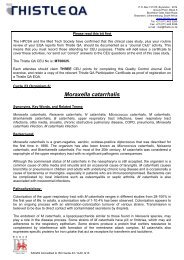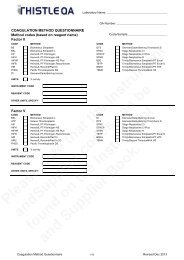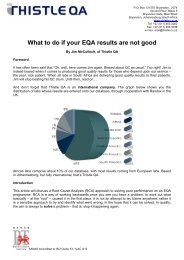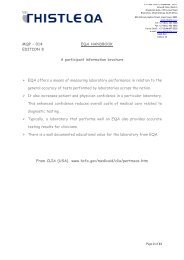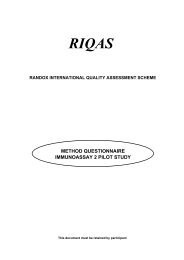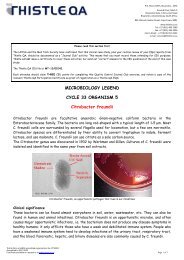Klebsiella pneumoniae - Thistle QA
Klebsiella pneumoniae - Thistle QA
Klebsiella pneumoniae - Thistle QA
- No tags were found...
You also want an ePaper? Increase the reach of your titles
YUMPU automatically turns print PDFs into web optimized ePapers that Google loves.
P.O. Box 131375, Bryanston, 2074<br />
Ground Floor, Block 5<br />
Bryanston Gate, Main Road<br />
Bryanston, Johannesburg, South Africa<br />
www.thistle.co.za<br />
Tel: +27 (011) 463 3260<br />
Fax: +27 (011) 463 3036<br />
e-mail : mail@thistle.co.za<br />
Please read this bit first<br />
The HPCSA and the Med Tech Society have confirmed that this clinical case study, plus your routine<br />
review of your E<strong>QA</strong> reports from <strong>Thistle</strong> <strong>QA</strong>, should be documented as a “Journal Club” activity. This<br />
means that you must record those attending for CEU purposes. <strong>Thistle</strong> will not issue a certificate to<br />
cover these activities, nor send out “correct” answers to the CEU questions at the end of this case study.<br />
The <strong>Thistle</strong> <strong>QA</strong> CEU No is: MT00025.<br />
Each attendee should claim THREE CEU points for completing this Quality Control Journal Club<br />
exercise, and retain a copy of the relevant <strong>Thistle</strong> <strong>QA</strong> Participation Certificate as proof of registration on<br />
a <strong>Thistle</strong> <strong>QA</strong> E<strong>QA</strong>.<br />
Cycle 22 Organism 5:<br />
<strong>Klebsiella</strong> <strong>pneumoniae</strong><br />
Three species of <strong>Klebsiella</strong> are associated with infections in humans: <strong>Klebsiella</strong> <strong>pneumoniae</strong>, <strong>Klebsiella</strong><br />
oxytoca, and <strong>Klebsiella</strong> granulomatis. The species <strong>Klebsiella</strong> ozaenae and <strong>Klebsiella</strong> rhinoscleromatis<br />
are considered as non-fermenting sub-species of K. <strong>pneumoniae</strong> that are associated with particular<br />
diseases. With certain exceptions, strains within the genus ferment lactose, and most produce highly<br />
mucoid colonies because of the production of a polysaccharide capsule. All species are non-motile.<br />
K. <strong>pneumoniae</strong> is a primary pathogen capable of causing urinary tract infections and pneumonia in<br />
otherwise healthy people, however most infections caused by K. <strong>pneumoniae</strong> are acquired in the<br />
hospital. Nosocomial infections, pneumonia and UTIs caused by K. <strong>pneumoniae</strong> may include wound<br />
infections, infection of invasive devices, biliary tract infections, peritonitis, and meningitis. K. <strong>pneumoniae</strong><br />
is second in incidence only to Escherichia coli as the causative agent of bacteraemia resulting from<br />
urinary tract infections. Pneumonia caused by K. <strong>pneumoniae</strong> has classically been described as having<br />
particular features, warranting the eponym “Friedländer’s disease”.<br />
The principal virulence factor that has been described for K. <strong>pneumoniae</strong> is its polysaccharide capsule,<br />
which come in over 70 antigenic varieties and is responsible for its mucoid growth on laboratory media.<br />
The mechanism by which the capsule promotes virulence is thought to be due inhibition of phagocytosis.<br />
K. <strong>pneumoniae</strong> can produce a variety of fimbrial types, including type-1 pili that are involved in<br />
adherence to host cells.<br />
All strains are resistant to ampicillin as a result of a chromosomal gene encoding to penicillin-specific<br />
beta-lactamase. Nosocomial isolates are frequently resistant to numerous other antibiotics as a result of<br />
the acquisition of multi-drug resistant plasmids. K. <strong>pneumoniae</strong> are the most common organisms to carry<br />
plasmids encoding for extended-beta-lactamases (ESBLs). For multi-resistant strains, especially those<br />
expressing ESBLs, treatment options are often reduced to the carbapenems (imipenem, meropenem,<br />
and ertapenem).<br />
SANAS Accredited to ISO Guide 43 / ILAC G13
Questions:<br />
1. How will you isolate and identify a K. <strong>pneumoniae</strong><br />
2. What types of infections are caused by K. <strong>pneumoniae</strong><br />
3. What are the recommended antimicrobial agents used to treat K. <strong>pneumoniae</strong> infections,<br />
especially the strains that produce ESBLs<br />
SANAS Accredited to ISO Guide 43 / ILAC G13


